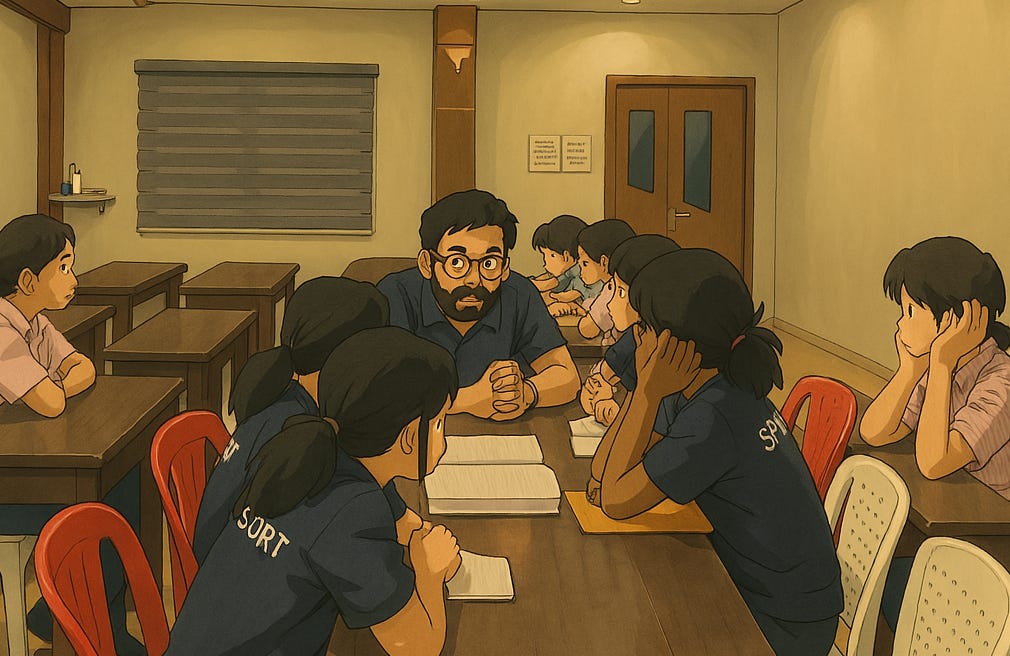When Joy Meets Theft – On the Ghibli AI Trend, and the Future of Art & Education in the Age of Algorithms
A gentle nostalgia has swept across the internet. Images of familiar faces and moments—rendered in the soft, magical hues of Studio Ghibli—are being shared with affection, humour, joy and love.
But is it all gentle?
There are wide-eyed characters standing under dreamy skies, people’s baby photos turned into gorgeous comic book characters, lovers proposing on dreamlike yachts, old homes and old friends, wrapped in pastel tones that feel—somehow—more romantic than the memories themselves. Even I uploaded a picture of myself, and within minutes, there I was, in Ghibli.
A never-seen-before version of me.
Helping me imagine what I might be like as a character in a lovable animated film or comic book.
It was deeply personal, playful, and honestly, immensely joyful.
The Ghibli trend, as it’s being called, has become a cultural artifact in real time. Propelled by recent upgrades in ChatGPT’s image interpretation technologies, it has allowed millions to reimagine their everyday lives as cinematic, story-worthy, and quietly magical.
But, as with anything that goes viral, not everyone is enchanted—and some of the criticism deserves our attention.
A Critical Instagram Post Reads:
“The Ghibli trend is everywhere. But let’s be honest—we’re not honouring the legacy. We’re flattening it. We’re trading brushstrokes for algorithms, emotion for efficiency… Art was never meant to be instant. It’s supposed to take time. It’s supposed to cost something—effort, intent, vulnerability.”
This argument—that art must be slow, effortful, exclusive to be real—is not new. Ghibli’s aesthetic didn’t fall from the sky. Artists laboured over every frame.
So, seeing that style recreated with prompts and clicks can feel… disrespectful. Lifeless. Hollow.
But I’m not convinced by that line of thinking.
I’m not claiming to be an animator. I’m not selling the image. I’m not replacing Miyazaki.
I’m just imagining myself in a world he shaped.
The Real Issue: Ethical Access
The real issue isn’t individual joy. It’s the tool that enables it.
Were Ghibli visuals part of the AI’s training data without permission?
Then what are we celebrating—democratized beauty, or the repackaging of someone else’s soul?
This shifts the debate from culture to ethics and law.
Users pay to use AI tools like ChatGPT Plus.
OpenAI earns from Ghibli-style aesthetics.
But Studio Ghibli isn’t compensated. No credit. No collaboration. No royalties.
This raises a fundamental issue of ethical AI training:
“Creators are being absorbed—their labour liquefied into a dataset, and monetized by a third party.”
Can You Copyright a Style?
Sam Altman (OpenAI CEO) has called the Ghibli trend a net win for society.
AI companies argue: “Can you copyright a style?”
Legally? No. Copyright protects characters and specific works, not style.
Ethically? That’s a different story.
If AI companies can monetize aesthetic styles without consent, we risk shifting the creative economy from artists to tech platforms.
So yes—while users feel personal joy, platforms own the play.
Two Coexisting Truths
People feel real, personal joy from AI-generated Ghibli-style art.
That joy is built on uncompensated artistic labour.
As F. Scott Fitzgerald once said:
“The test of a first-rate intelligence is the ability to hold two opposing ideas in the mind at the same time and still retain the ability to function.”
We must all learn to live with nuance, complexity, and contradiction.
The Bigger Picture: Education, Culture, and Responsibility
This trend isn’t just about art. It’s a mirror.
It shows how we want to see ourselves:
Tender. Whimsical. Lovable. Larger than life—even for a moment.
So the question becomes:
How do we honour that emotional hunger for beauty and belonging, without exploiting the very artists who made it possible?
The answer isn’t censorship. It’s design.
We’ve seen platforms like YouTube and Instagram create imperfect—but existing—systems of copyright credit and revenue sharing.
We need similar ethical imagination in AI.
AI tools aren’t just technical marvels. They are cultural actors.
Their impact will be guided not just by engineers, but by educators, parents, artists, policy-makers—anyone who cares about what we leave for the next generation.
After all, people aren’t trying to replace Miyazaki.
They’re trying to meet him halfway.
To say:
“Your worlds touched us. Let us touch them back.”
In an age of instant remixing, the question isn’t whether beauty should be shared—
but how to share it justly.
This article was translated & published in Janpath (April 2025 Issue, Page 6)
Download: Janpath Samachar PDF

